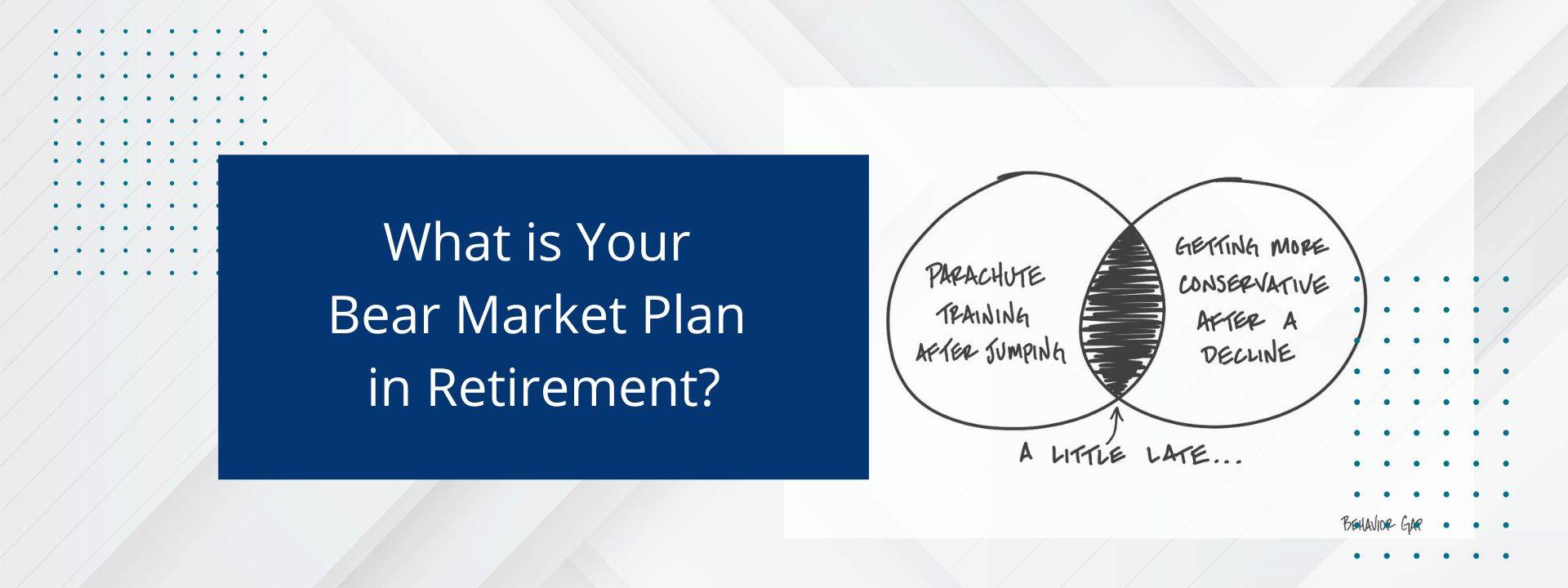Just like the sketch above by Carl Richards, becoming more conservative after a market decline is not a strategy but a reaction. Everyone should have a plan in place before any market decline or bear market.
Unfortunately, market declines and recessions will happen regularly, so your financial and retirement plans must consider them when developing your retirement income and spending strategy.
You Could Have 6 Bear Markets Over Your Retirement
Since 1956, the Canadian stock market has had 12 bear markets, averaging one major market decline every 5 years. In a retirement span lasting 30 years or more you might experience 6 market crashes, corrections, or downturns. While you can’t predict when they’ll happen, you need to be prepared with a strategy in place.
For instance, if you retired in 1994, you would have faced:
- 1997 Asian Financial Crisis
- 2000-2002 Dot-Com Bubble Burst
- 2001 September 11th Attacks
- 2007-2008 Global Financial Crisis
- 2010 European Debt Crisis (Greece)
- 2015-2016 Chinese Stock Market Turmoil
- 2018 Market Correction
- 2020 COVID-19 Pandemic
- 2022 Market Volatility (bonds and equities declined)
What Should Be Part of Your Bear Market Plan?
Here are key items to consider:
- Review Your Retirement Income Plan Annually
- Know What Spending You Can Adjust
- Have Cash Reserves for Major Expenses
- Create a Globally Diversified Portfolio
- Consider a Bucket Approach
- Rebalance Your Investments
- Pay Down Debt with Cash
- Obtain a Line of Credit
1. Review Your Retirement Income Plan Annually
When your retirement income plan was developed, ideally both bull and bear markets were taken into consideration to determine an appropriate investment allocation and spending amounts that could be sustainable over your lifetime.
2. Know What Spending You Can Adjust
One thing you can control during market downturns is your spending. Taking less from your retirement portfolio during these times can help. Review and allocate your expenses into core and adaptive categories. Core expenses, like real estate taxes and home insurance, are non-negotiable, while adaptive expenses, such as delaying a new car purchase or driveway repairs, can be reduced or deferred.
3. Have Cash Reserves for Major Expenses
Maintain cash investments for any major expenses that may occur in the next 36 months. This ensures you won’t need to sell investments that have decreased in value to access cash.
4. Create a Globally Diversified Portfolio
Review your portfolio allocation to confirm it is still appropriate for your requirements. A globally diversified portfolio typically includes:
- Canadian Equities
- US Equities
- Global Equities
- Canadian Income
- Global Income
Regularly review your specific mix to ensure it hasn’t drifted toward a larger weighting in a previously best-performing asset class.
5. Consider a Bucket Approach in Retirement
A bucket strategy divides your diversified portfolio into three main categories:
- Cash Bucket: 1-2 years of spending
- Income Bucket: 2-6 years of spending
- Growth Bucket: Longer-term growth
This approach allows your growth investments (equities) to rebound during market downturns, as you may not need to touch them for up to 8-10 years.
6. Rebalance Your Investments
Annually review if it makes sense to rebalance your investments back to your target allocation. Without rebalancing, your investment allocation can drift, possibly resulting in an overweight in an asset category that does not align with your strategy. This can help automate the “sell high and buy low” strategy.
7. Pay Down Debt with Cash
With rising interest rates, it makes sense to pay down or pay off debt if you have the cash on hand. If you’re paying an interest cost of 6.45%, you’d need to earn 12.9% on your money before tax to pay it off. Paying off debt can be like a guaranteed rate of return on your money.
8. Obtain a Line of Credit
Having a line of credit in place for large emergencies can prevent you from having to sell investments that may have temporarily declined. Once the investments recover, you can sell them to pay off the line of credit.
When the Bear Market Hits
Avoid doing anything drastic:
- It can be tempting to exit the market and re-enter when things look better, but by then the market is often higher than when you moved out, causing you to miss the recovery.
- Remember, downturns don’t last forever. In Canada the average bull market lasts 41 months, while the average bear market lasts 10 months (Source: BMO, from June 1960 to Dec 31, 2021).
- Review your withdrawal rate and rerun your plan to see if any spending adjustments are necessary.
- Consider tax loss selling opportunities. If an investment’s market value is less than its cost base, you might sell to create an investment loss and reposition that investment. You can carry capital losses back 3 years and forward indefinitely.
Market declines will happen regularly during your retirement. Therefore, your financial and retirement plans must account for these potential downturns when developing your strategy.
What To Do Next
Are You on Track with Your Retirement Strategy? FIND OUT TODAY!
For more information, refer to Preserving Wealth: The Next Generation – The definitive guide to protecting, investing, and transferring Wealth by Jack Lumsden, MBA, CFP® or schedule a call with Jack at 905-332-5503
Jack Lumsden is a Financial Advisor with Assante Financial Management Ltd. The opinions expressed are those of the author and not necessarily those of Assante Financial Management Ltd. Please contact him at 905.332.5503 or visit www.jacklumsden.com to discuss your circumstances before acting on the information above.


